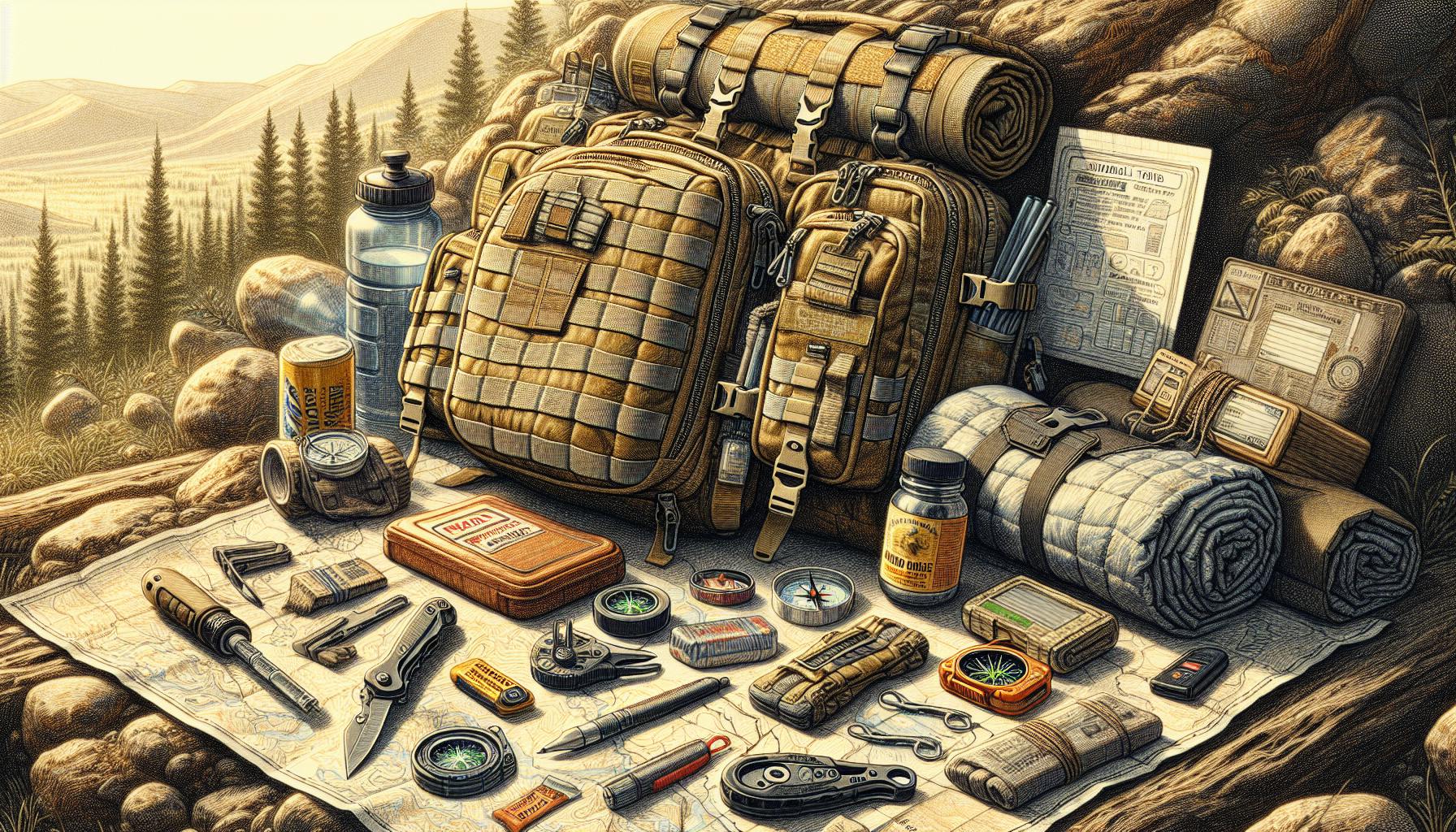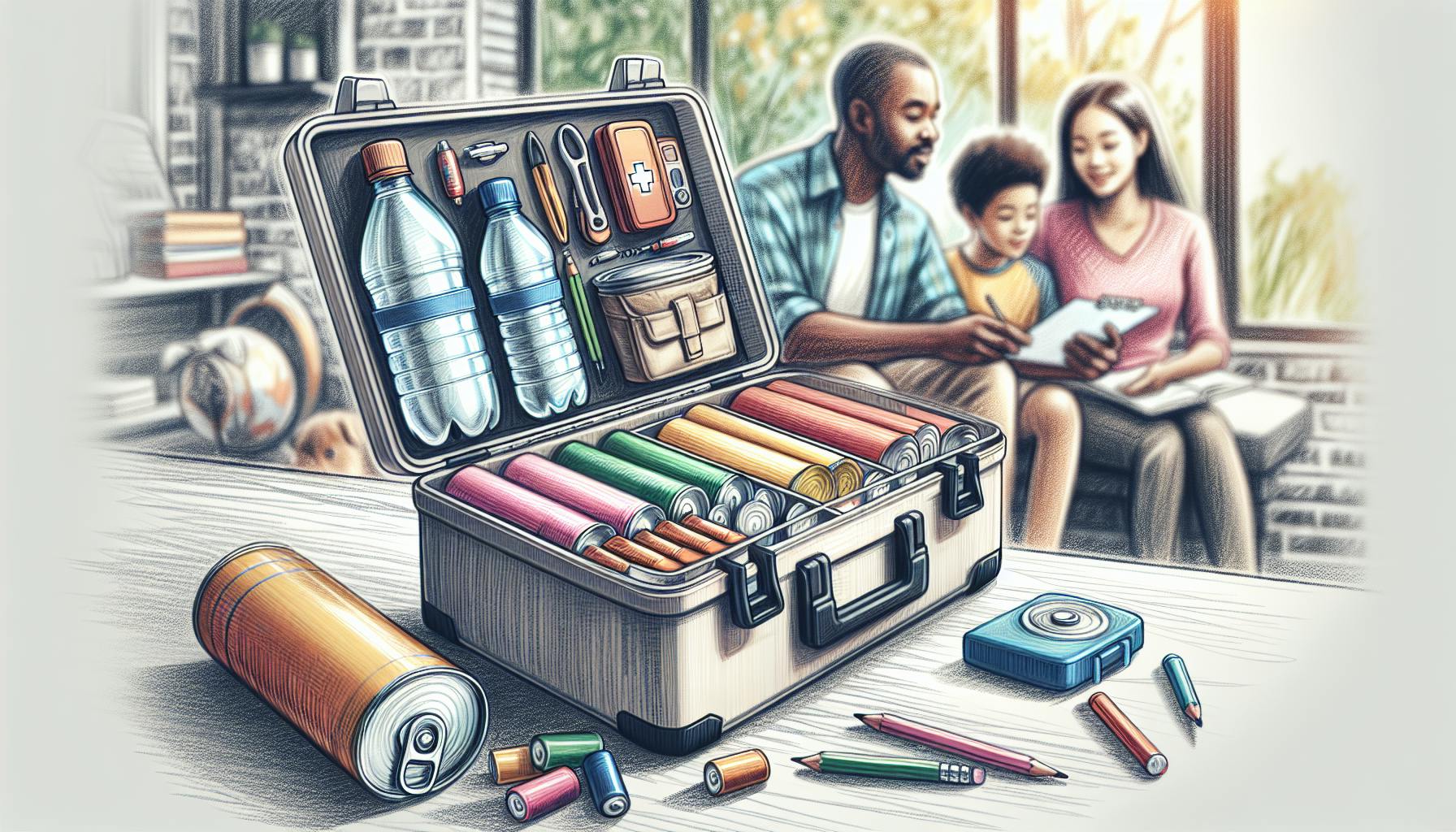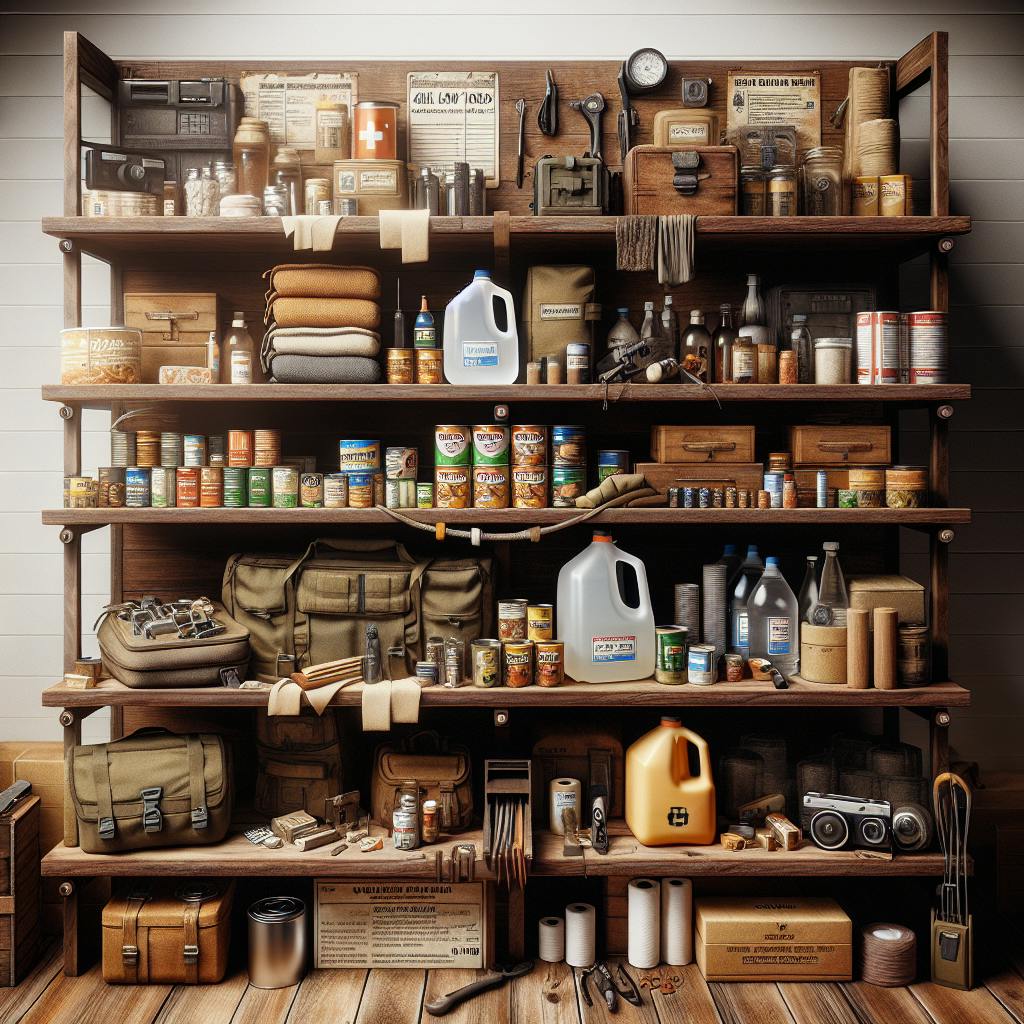Preparing a 3 day bug out bag is an important step, but customizing it for your specific needs and situation is crucial for maximum efficiency.
With some planning and forethought, you can optimize your 3 day bug out bag to address regional threats, leverage your existing skills, and carry just what you need to survive 72 hours on the go.
In this article, we'll cover key strategies for customizing your bug out bag contents based on your location, skills, and likely emergency scenarios, helping you build the most practical and portable 3 day bug out bag for your situation.
Introduction to Building the Best 3 Day Bug Out Bag
A bug out bag should contain essentials tailored to your needs. This article provides tips on customizing your 3 day bug out bag for your region, skills, and potential emergency situations.
Understanding the Purpose of a 3 Day Bug Out Bag
A 3 day bug out bag is a portable kit that contains critical supplies to survive for 3 days in an emergency situation where you need to evacuate quickly. It prepares you for scenarios like natural disasters, civil unrest, or other crisis events that disrupt normal services and supply chains.
Having an emergency 3 day bug out bag allows you to leave dangerous areas safely and meet basic survival needs while you make your way to a secure location. It should contain food, water, first aid, tools, and other gear selected based on likely regional threats, personal skills/needs, and potential length of evacuation.
Customizing your bug out bag is essential so you have what you specifically require to endure several days, accounting for factors like climate, terrain, health status, specialized medications, etc. An improperly packed 3 day bag risks leaving out something vital given your situation.
Identifying Personal Needs for a Tailored Survival Bag List
When making a 3 day bug out bag list, thoroughly evaluate:
- Your region's common emergencies and typical duration. This determines gear for likely weather, terrain, shelters, food/water sources.
- Personal health, fitness level, skills. Account for prescription medications, mobility limitations, specialized equipment you rely on.
- Who will be with you? Children, elderly, pets have unique needs.
- What locations would you likely evacuate to? Nearby home of a friend or relative? A remote campsite? Shelter options influence gear choices.
Document these factors first so your customized bug out bag list targets your specific risks, needs, and plans.
For example, a minimalist 3 day bug out bag for a healthy adult evacuating to a nearby fully-stocked home would differ greatly from someone with medical issues hiking remote mountain trails for multiple days.
Balancing Practicality and Portability in Your Bug Out Bag
A 3 day bug out bag must contain adequate gear while remaining portable enough for extended evacuation travel. Focus on multipurpose items that satisfy several needs to avoid overweight bags.
Prioritize by function then condense by volume/weight:
- Determine the critical supply categories (water, food, shelter, first aid, etc.)
- Select versatile items that serve multiple functions (metal water bottle doubles as cooking pot)
- Condense heavy items (dehydrate food, miniaturize tools)
Establish weight/space thresholds based on your strength, mobility, transport method. Test fully loaded bag with long distance movement. Remove non-essential items if too heavy/cumbersome.
Targeting core survival needs through a personalized 3 day bug out bag list optimizes practicality and portability for your situation.
How big should a 3 day bug out bag be?
Most experts recommend a 3 day bug out bag in the 40-55 liter range (2,450-3,350 cubic inches). This size allows you to pack the essentials without getting too heavy or bulky.
When deciding on your bag size, consider these factors:
- Your body size and strength - make sure you can comfortably carry it over long distances
- Regional threats - if you may need cold weather gear, pack a larger bag
- Activity level - if hiking to your destination, pack lighter
- Additional people - increase capacity if packing for more than yourself
A good way to estimate bag size is to stuff it with blankets or pillows to match the desired capacity. Measure the fully packed dimensions.
Over 65 liters is usually excessive and under 35 liters can be too limiting for a 3 day supply. If using an existing pack, determine its size before stuffing to capacity.
The right bug out bag size balances your needs for capacity and portability. With some planning, most people find a 40-55 liter bag hits the sweet spot.
How many days should a bug out bag last?
A bug out bag is designed to provide the essentials to survive for 72 hours or 3 days while you seek more permanent shelter and resupply your gear. This relatively short timeframe means your bug out bag needs to be ready to go at a moment's notice.
Here are some tips for ensuring your 3 day bug out bag is equipped for a quick evacuation:
- Take inventory of your supplies every 6 months and replace any expired or damaged items
- Pack high-calorie, non-perishable foods like protein bars, dried fruits, and nuts
- Include a portable water filtration system and backup water supply
- Choose multifunctional tools and first aid supplies tailored to likely regional threats
- Keep your bug out bag packed and easily accessible in your home or vehicle
The key is having all your critical survival items consolidated in a single grab-and-go bag so that you can evacuate as efficiently as possible when an emergency strikes. Maintaining and customizing your 3 day kit based on your skills, climate, and potential risks will help maximize your chances of survival during those critical first 72 hours.
What do you put in a doomsday bag?
A basic disaster supplies kit for a doomsday scenario should contain the essentials to survive for at least 3 days. Here are some of the most important items to include:
Water
- 1 gallon of water per person per day for drinking and sanitation
- Water filtration system like a Lifestraw or Sawyer filter
Food
- High-calorie, non-perishable foods like granola bars, nuts, jerky
- MREs or freeze-dried backpacking meals
Communication and Navigation
- Battery-powered or hand crank AM/FM radio
- Weather radio to receive emergency alerts
- Map and compass for navigation
Light and Power
- LED flashlight
- Headlamp for hands-free light
- Extra batteries
- Portable charger and cables
First Aid Supplies
- First aid kit with bandages, gauze, ointments
- Medications and prescriptions
- Whistle to signal for help
Customize your 3 day bug out bag based on your region, skill level, and potential threats. Prioritize lightweight, multi-use gear to save weight and space.
What's the difference between a go bag and a bug out bag?
A go bag and a bug out bag serve similar purposes, but have some key differences.
Go Bag
- Designed for short-term emergencies lasting up to 72 hours
- Focused on essentials to "grab and go" quickly
- Typically kept in home or car for immediate access
Bug Out Bag
- Designed for longer-term survival (3+ days)
- Contains more gear and provisions
- Focused on evacuating to alternative location
The main distinction is that a go bag is intended for short-term, immediate crises where you may need to leave quickly and survive for a couple days. A bug out bag prepares you for a longer evacuation from 3-7+ days where you leave your home for an alternate secure location.
When customizing your 3 day bug out bag, focus on the essentials like food, water, shelter, navigation, and other critical survival basics. Choose lightweight and durable gear that meets your personal needs. Test and adjust your bug out bag over time to find the ideal balance of essentials versus "nice-to-have" items.
sbb-itb-b932644
Assessing Your 3 Day Bug Out Bag Survival Needs
Before packing your 3 day bug out bag, it's important to thoroughly assess your specific survival needs to ensure you are fully prepared. This involves evaluating your personal skills, regional threats, and packing the essential food, water, and gear to survive for 3 days.
Survival Skills Assessment for Bug Out Bag Readiness
- Take stock of your existing survival skills like fire starting, shelter building, navigation, and first aid. Identify any gaps to guide your bug out bag packing list.
- Consider taking local classes or online courses to boost critical skills like orienteering, edible plant identification, trap setting, and emergency medical care. These can literally save your life in a disaster scenario.
- Practice essential skills like building shelters, filtering water, and using navigation tools before an actual emergency. Hands-on repetition develops muscle memory and confidence when it really counts.
Regional Considerations for Bug Out Bag Customization
- Research the likely disasters and environmental extremes for your region like earthquakes, flooding, storms, heat or cold waves.
- Pack gear specifically for those expected conditions like waterproof layers, insulated boots, or dust masks. Location-appropriate gear vastly improves chances of survival.
- Understand limitations of your area that may require special preparation like scarce drinkable water, lack of shelter building materials, or extremes of hot or cold. Address these in your bug out bag.
3 Day Food and Water Essentials
- Pack at least 1 gallon or 4 liters per person for a 3 day supply. Consider packing water filtration or purification tools as well.
- Choose calorie-dense dried, canned, or sealed foods that won't easily spoil like nuts, jerky, and meal replacement bars. Calculate for at least 2,000 calories per day.
- Include utensils, a stove, and mess kit to be able to cook food and boil water. Key for morale and energy.
Following these steps for honest assessment and thoughtful bug out bag customization can provide the critical survival insurance to weather an unexpected disaster scenario.
Top 10 Bug Out Bag Essentials
There are certain items that every 3 day bug out bag should have. Here's a rundown of the top 10 essentials.
Critical Navigation Tools for Evacuation
Having the right navigation tools like maps, compasses, and GPS devices can mean the difference between life and death when evacuating a disaster area. Choose maps of your local area as well as surrounding regions in case you need to travel farther. Make sure your compass is high quality and you know how to use it properly with a map. A handheld GPS device can pinpoint your location if you become lost.
First Aid Necessities for Immediate Medical Response
No bug out bag is complete without a well-stocked first aid kit. At minimum, it should contain bandages, gauze, antibiotic ointment, pain medication, safety pins, scissors, tweezers, thermometer, and first aid instruction manual. Tailor your kit based on your medical needs, skills, and regional threats. Having the ability to immediately treat injuries when medical help is unavailable is vital.
Fire Starting Kit for Warmth and Food Preparation
Include waterproof matches, lighter, fire starters, tinder, and kindling in your survival bag to start fires for warmth or cooking. Practice fire starting skills using various methods ahead of time. Fires provide warmth, light, ability to purify water, and cook food when evacuating. Assembling a comprehensive fire starting kit prepares you for this essential survival task.
Customizing Your Bug Out Bag for Specific Emergencies
Tailoring your 3 day bug out bag to the potential emergencies you may face can help ensure you have the necessary supplies and are fully prepared. Here are some tips for customizing your bug out bag for different disaster scenarios.
Preparing for Natural Disasters: Floods, Earthquakes, and More
When facing potential natural disasters like floods, earthquakes, tornadoes, or hurricanes, having a well-stocked 3 day bug out bag is crucial. Consider packing:
- Sturdy, waterproof boots and rain gear to stay dry
- Thermal clothing and mylar blankets for warmth
- Water purification tablets, collapsible water bottle
- High-calorie, lightweight emergency food rations
- First aid kit with trauma supplies
- Flashlights, battery packs and batteries
- Duct tape, paracord, zip ties for repairs and shelter
Focus your natural disaster bug out bag on durability, warmth, clean water access, medical care, and shelter creation.
Equipping for Civil Unrest: Staying Safe and Mobile
Civil unrest events like protests or riots require different bug out bag considerations. Prioritize:
- Clothing that allows you to blend into crowds
- Protective items like gas masks, goggles, gloves
- Mobile communication devices and portable chargers
- Cash in small bills
- Lightweight, non-perishable food
- Maps, compass for navigation if cell towers are down
Having multiple escape route options and being able to move quickly on foot are key for civil unrest preparedness.
Wildfire Readiness: Respiratory Protection and Fire Shelter
Those in wildfire-prone areas need specific supplies in their 3 day bug out bags. Have:
- N95 respirators to filter smoke particles
- Fire shelter tent
- Fire-resistant clothing, gloves, goggles
- Multi-tool for brush clearance if trapped
- Face covers, bandanas, scarves to protect airways
Focus your efforts on respiratory and fire protection when prepping wildfire bug out bags.
Maintaining and Updating Your Minimalist Bug Out Bag List
Keeping your bug out bag up-to-date and ready to go at a moment's notice is essential for being prepared for any emergency situation. Conducting regular inspections, practical drills, and upgrading with the latest survival innovations can help ensure your 3 day bug out bag is optimized for survival.
Regular Inspection and Refresh of Bug Out Bag Contents
It is recommended to inspect the contents of your bug out bag at least every 3 months. Check expiration dates on food, water, medicine, and batteries. Replace any degraded, expired, or missing items. Also ensure nothing has shifted or broken within the bag that could compromise the utility of the gear.
After an inspection, set a calendar reminder for your next bug out bag checkup. Maintaining this regular schedule is key to keeping your 3 day bug out bag survival supplies fresh and intact. Mark inspections on your calendar to help build the habit.
Practical Bug Out Drills to Ensure Readiness
Conduct periodic bug out drills by grabbing your bag and evacuating your home as if a real emergency was unfolding. Time how long it takes you to get out the door. This will test your muscle memory in a crisis and identify any hindrances in a real evacuation.
Also conduct a full inventory after evacuating by laying out all the contents of your bag. Check if anything shifted significantly or spilled during transit. Identify ways to better secure gear. Testing your bug out protocol routinely ensures your 3 day bug out bag list will perform when you need it most.
Upgrading Your Survival Gear with the Latest Innovations
Sign up for updates from survival gear manufacturers to stay current on the latest emergency preparedness products and innovations. For example, upgrades in water filtration, fire starting kits, shelter materials, and other essentials can greatly boost the utility of your 3 day bug out bag.
Read prepper blogs and forums to research the newest must-have survival tools to add to your bug out bag list. Continuously upgrading with cutting-edge gear ensures you get the most out of your minimalist bug out bag.
Conclusion: Optimizing Your 3 Day Bug Out Bag for Maximum Efficiency
Optimizing your 3 day bug out bag is key to being prepared for emergencies. Here are some tips to help maximize efficiency:
Recap of Customization Strategies for Your Bug Out Bag
- Assess your needs - Consider your climate, likely risks, and personal skills when packing
- Prioritize essentials - Food, water, first aid should take top priority
- Pack light - Only include necessary items to reduce weight
- Test gear functionality - Ensure all gear is in working order before packing
The Importance of Regular Testing and Maintenance
- Inspect contents every 6 months - Replace expired items as needed
- Test bag weight and fit - Make adjustments so it is not too heavy or awkward
- Practice essential skills - Brush up on first aid, navigation, shelter building
- Rotate food/water - Use up and replace items before they expire
Regular testing and maintenance helps ensure your bug out bag is ready when you need it.
Final Thoughts on Building the Best 3 Day Bug Out Bag
Customizing your bug out bag to your specific situation is key for an efficient and useful survival kit. Regular inspection and practice will keep both your skills and gear in top shape. An optimized 3 day bag can mean the difference between life and death in an emergency.


